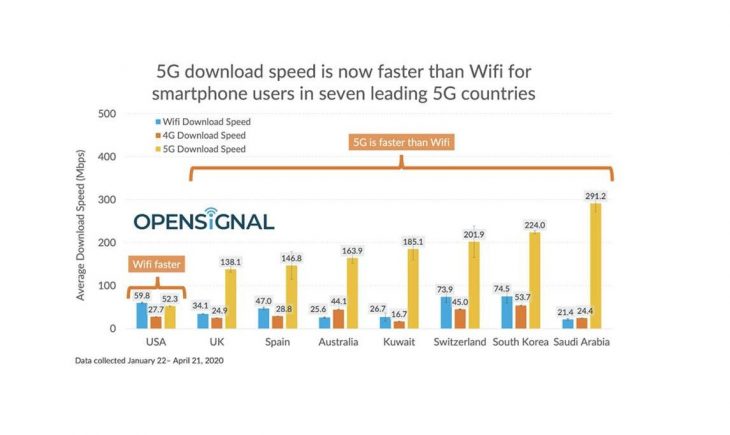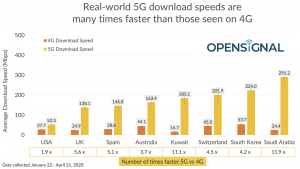
NEW ANALYSIS IS showing that in seven countries which have begun to roll out 5G wireless service, download speeds are eclipsing what in-home Wi-Fi can deliver.
According to market insights firm Opensignal, the U.S. is the exception, where Wi-Fi continues to hold an edge over 5G because American users are connecting on widely available, but relatively slow, 5G networks that are deployed using low frequency spectrum bands. Data was collected between January 22 and April 21, 2020.
“In most countries, initial 5G services have been offered exclusively on fast high capacity mid-band spectrum — around 3.5Ghz, sometimes called the C-band — but in the U.S. T-Mobile and AT&T have launched their main service on low-band spectrum which has less capacity, but is better suited to offering wide coverage. In the U.S. as elsewhere, carriers will increasingly offer 5G on higher mid-band frequency bands and as they do, average U.S. 5G speeds will rise significantly,” reads the Opensignal release.
In Canada, 5G has of course only barely launched and mid-band spectrum won’t be auctioned off by the federal government until December – meaning it won’t be deployed until 2021 at the earliest.
That said, “cellular connectivity will not replace Wi-Fi anytime soon,” says the company. “Wi-Fi and mobile technology are complementary. However, with rising speeds and additional spectrum capacity, 5G services will make the cellular experience increasingly valuable, and mean that in more situations smartphone users will see a faster service if they switch off Wi-Fi and use their regular mobile connection.”
As well, 5G is significantly faster than 4G. “The difference in 5G download speed between each country is mainly because of the different amount of spectrum used to deploy the 5G service. Where operators have used near 100 MHz of spectrum they’ve typically offered users speeds faster than those operators limited to 40 MHz or 50 MHz 5G channel sizes. The quality of the ‘backhaul’ connections to each 5G base station — the way each cell tower is connected onto the main network — also affect the real-world experience.”



